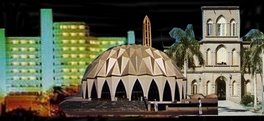According to The World Factbook, the primary religions of Sudan are Muslim(approx. 70%), Christianity(approx. 5%) and traditional indigenous religions(approx. 25%). Sunni Muslims predominate in the north, while the south contains most of the followers of Christianity and traditional indigenous religions (animists).[1]
In the early 1990s, the largest single category among the Muslim peoples of Sudan consisted of those speaking some form of Arabic. Excluded were a small number of Arabic speakers originating in Egypt and professing Coptic Christianity. In 1983 the people identified as Arabs constituted nearly 40 percent of the total Sudanese population and nearly 55 percent of the population of the northern provinces. In some of these provinces (Al Khartum, Ash Shamali, Al Awsat), they were overwhelmingly dominant. In others (Kurdufan, Darfur), they were less so but made up a majority. By 1990 Ash Sharqi State was probably largely Arab. It should be emphasized, however, that the acquisition of Arabic as a second language did not necessarily lead to the assumption of Arab identity.
In the early 1990s, the Nubians were the second most significant Muslim group in Sudan, their homeland being the Nile River valley in far northern Sudan and southern Egypt. Other, much smaller groups speaking a related language and claiming a link with the Nile Nubians have been given local names, such as the Birqid and the Meidab in Darfur State. Almost all Nile Nubians speak Arabic as a second language.
[edit] Christianity
Christianity was most prevalent among the peoples of Al Istiwai State--the Madi, Moru, Azande, and Bari. The major churches in the Sudan were the Catholic and the Anglican. Southern communities might include a few Christians, but the rituals and world view of the area were not in general those of traditional Western Christianity. The few communities that had formed around mission stations had disappeared with the dissolution of the missions in 1964. The indigenous Christian churches in Sudan, with external support, continued their mission.
[edit] Indigenous religions
Each indigenous religion is unique to a specific ethnic group or part of a group, although several groups may share elements of belief and ritual because of common ancestry or mutual influence. The group serves as the congregation, and an individual usually belongs to that faith by virtue of membership in the group. Believing and acting in a religious mode is part of daily life and is linked to the social, political, and economic actions and relationships of the group. The beliefs and practices of indigenous religions in Sudan are not systematized, in that the people do not generally attempt to put together in coherent fashion the doctrines they hold and the rituals they practice.














No comments:
Post a Comment